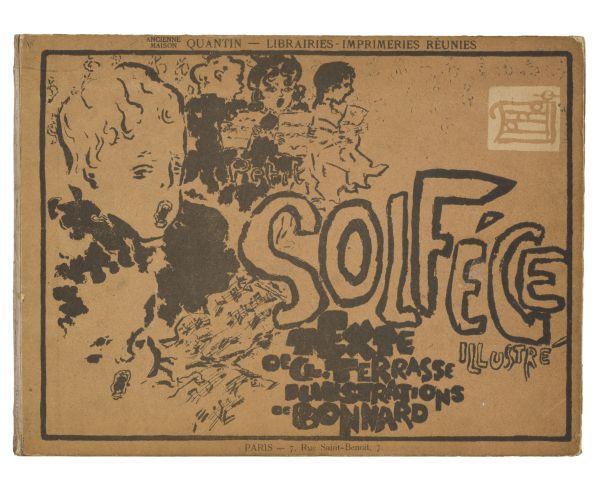Petit solfège illustré
Artist: Pierre Bonnard (French, 1867-1947)
Publisher: Ancienne Maison Quantin, Librairies-Imprimeries Réunies, Paris, [1893]
Printer: Allier Père et Fils, Grenoble
Author: Claude Terrasse (French, 1867-1923)
Date: [1893]
Dimensions:
Book: H: 8 3/8 in. (212 mm); W: 11 1/4 in. (286 mm); Depth: 3/16 in. (5 mm).
Page: H: 8 3/8 in. (212 mm); W: 11 1/8 in. (283 mm).
Medium: Reproductions: 31 relief etchings in colors on cream wove paper, incl. cover
Classification: Books
Credit Line: Gift of Molly and Walter Bareiss
Object number: 1984.275
Label Text:Bonnard's first illustrated book, a collaboration with his brother-in-law Terrasse (1867-1923), was designed for children. In the first sentence a solfege is defined as a book which explains the basic rules of music. Bonnard's comical drawings, which are photomechanically reproduced, frame and elucidate the text with a playful verve intended to delight a youthful reader.
Pierre Bonnard, Petit solfège illustré (Little Illustrated Music Theory Book). Music by
Claude Terrasse (1893)
Pierre Bonnard, Petites scènes familières pour piano (Intimate Little Scenes for
Piano). Music by Claude Terrasse, Lyrics by Franc-Nohain (1895)
The French artist Pierre Bonnard had tried in the1890s to enter the lucrative business of illustrating sheet music covers. Although unsuccessful, this effort inspired him to collaborate with his brother-in-law, the composer and teacher Claude Terrasse, on a music theory book for children. The result was Bonnard’s first illustrated book, Petit solfège illustré. Although Terrasse’s text was dry, Bonnard’s illustrations were amusing and inventive.
Two years later, Bonnard collaborated with Terrasse on an edition of piano music for use in the home. The book featured such family-oriented songs by Terrasse as the lullaby Do, do, l'enfant, do, (Sleep, Sleep, Baby, Sleep) and Chanson du grand-père (Grandfather’s Song). The poet Franc-Nohain wrote the lyrics.
Bonnard worked on the designs while he was visiting Terrasse and his sister in the little town of Arcachon. His sister’s family and the town became the models for many of the images. The lithographs, painted with brush and ink, were influenced by Japanese art.
Pierre Bonnard, Petit solfège illustré (Little Illustrated Music Theory Book). Music by
Claude Terrasse (1893)
Pierre Bonnard, Petites scènes familières pour piano (Intimate Little Scenes for
Piano). Music by Claude Terrasse, Lyrics by Franc-Nohain (1895)
The French artist Pierre Bonnard had tried in the1890s to enter the lucrative business of illustrating sheet music covers. Although unsuccessful, this effort inspired him to collaborate with his brother-in-law, the composer and teacher Claude Terrasse, on a music theory book for children. The result was Bonnard’s first illustrated book, Petit solfège illustré. Although Terrasse’s text was dry, Bonnard’s illustrations were amusing and inventive.
Two years later, Bonnard collaborated with Terrasse on an edition of piano music for use in the home. The book featured such family-oriented songs by Terrasse as the lullaby Do, do, l'enfant, do, (Sleep, Sleep, Baby, Sleep) and Chanson du grand-père (Grandfather’s Song). The poet Franc-Nohain wrote the lyrics.
Bonnard worked on the designs while he was visiting Terrasse and his sister in the little town of Arcachon. His sister’s family and the town became the models for many of the images. The lithographs, painted with brush and ink, were influenced by Japanese art.
Not on view
In Collection(s)







